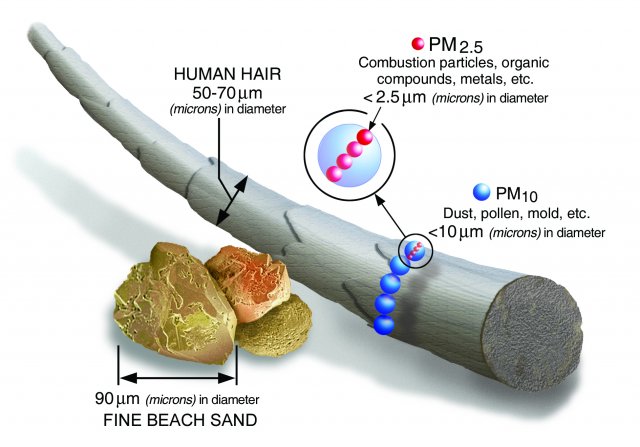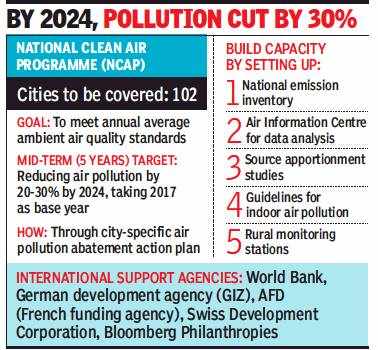Description

Copyright infringement is not intended
Context: No country in 2021 met the updated air quality guidelines defined by the World Health Organization (WHO), a new report found.
- In September 2021, the WHO tightened the global air quality norms and lowered the annual concentration of PM2.5 to five microgram (μg) from 10μg.
- IQ Air is a Swiss air quality technology company specialising in protection against airborne pollutants, and developing air quality monitoring and air cleaning products.
Key findings of report by report by IQAir:
- Concentration of particulate matter 2.5 (PM2.5) was found to be within WHO standards in only 222 out of 6,475 cities.
- The concentration in 93 per cent of the cities was 10 times the new guidelines. This was the case in 48 per cent of India’s cities.
- Dhaka (Bangladesh), N’Djamena (Chad), Dushanbe (Tajikistan) and Muscat (Oman) followed Delhi in the list of polluted capital cities.
- India specific:
- India was among the top five countries with the highest concentration of PM2.5
- Delhi is the most polluted capital in the world. The city recorded an increase of over 14 per cent in the concentration of PM2.5 in 2021 compared to 2020.
- Of the 15 most polluted cities in Central and South Asia in 2021, 12 were in India.
What is Particulate Matter 2.5 (PM2.5)?
- The term fine particles, or particulate matter 2.5 (PM5), refers to tiny particles or droplets in the air that are two and half microns or less in width.
PM2.5 effect on health
- Particles in the PM5size range are able to travel deeply into the respiratory tract, reaching the lungs.
- Exposure to fine particles can cause short-term health effects such as eye, nose, throat and lung irritation, coughing, sneezing, runny nose and shortness of breath.
- Long term exposure to fine particulate matter may be associated with increased rates of chronic bronchitis, reduced lung function and increased mortality from lung cancer and heart disease.
Where does PM2.5 come from?
There are outdoor and indoor sources of fine particles.
- Outside, fine particles primarily come from car, truck, bus and off-road vehicle (e.g., construction equipment, snowmobile, locomotive) exhausts, other operations that involve the burning of fuels such as wood, heating oil or coal and natural sources such as forest and grass fires. Fine particles also form from the reaction of gases or droplets in the atmosphere from sources such as power plants.
- PM5is also produced by common indoor activities like tobacco smoke, cooking (e.g., frying, sautéing, and broiling), burning candles or oil lamps, and operating fireplaces and fuel-burning space heaters (e.g., kerosene heaters).
International impact of PM 2.5
- The WHO estimates that air pollution “kills an estimated seven million people worldwide every year” and their data “shows that 9 out of 10 people breathe air containing high levels of pollutants.
- NASA satellite data pertaining to PM 2.5 and found that “more than 4 in 10 Indians are exposed to 5 times the safe limit of particulate matter in the air they breathe
Measure taken by GoI:
National Clean Air Program (NCAP)
- It was launched in 2019.
- Aim:to reduce pollution by 20-30 % by 2024, particularly in 132 non-attainment cities.
- Fund allocation: Under the NCAP, Rs 375.44 crore was provided to 114 cities from 2018-19 to 2020-2021 and Rs 290 crore allocated to 82 cities for 2021-2022. The programme has an allocation of Rs 700 crore envisaged for 2021-2026.
- Target to bring down pollution by 2024:
- Country’s current annual safe limits for PM 2.5 and PM 10 are 40 micrograms/per cubic metre (ug/m3) and 60 micrograms/per cubic metre.
- The NCAP has set a target of reducing key air pollutants PM10 and PM2.5 (ultra-fine particulate matter) by 20-30% by 2024, taking the pollution levels in 2017 as the base year.
- Membership:Apart from experts from the industry and academia, the programme is expected to be a collaboration between the Ministry of Road Transport and Highways, Ministry of Petroleum and Natural Gas, Ministry of New and Renewable Energy, Ministry of Heavy Industry, Ministry of Housing and Urban Affairs, Ministry of Agriculture, Ministry of Health, NITI Aayog, and Central Pollution Control Board.

https://www.downtoearth.org.in/news/pollution/every-country-exceeds-new-pm2-5-annual-limit-set-by-who-report-82022












